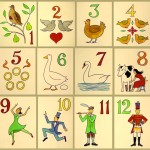 It’s one of my least favorite Christmas carols. It’s obnoxiously repetitive, ranking right up there with that long-bus-ride favorite, “100 Bottles of Beer on the Wall.” It’s nonsensical, with its references to dancing ladies, leaping lords, and half a dozen varieties of bird. It seems that the song, like so many TV commercials, must have been inspired by late nights and an excess of wassail and eggnog.
It’s one of my least favorite Christmas carols. It’s obnoxiously repetitive, ranking right up there with that long-bus-ride favorite, “100 Bottles of Beer on the Wall.” It’s nonsensical, with its references to dancing ladies, leaping lords, and half a dozen varieties of bird. It seems that the song, like so many TV commercials, must have been inspired by late nights and an excess of wassail and eggnog.
And yet, for all its faults, perhaps “The Twelve Days of Christmas” can serve for us as sort of an Advent-in-reverse, extending the significance of the holiday beyond the family gatherings and the feverish unwrapping of gifts.
Celebrating the Twelve Days of Christmas—the actual days, not the song, which was written around 1780—has taken place for hundreds of years…at least as far back as the Council of Tours in AD 567. Included by different Christian traditions during these days are celebrations of the birth of Jesus (Dec 25), His circumcision (Jan 1), and Epiphany or Three Kings Day (Jan 6).
In recent decades, some have suggested that the song was an encoded catechism, a training tool for Catholic children. That idea, it seems, was concocted in the imagination of a Canadian hymnologist, Hugh McKellar, seeking religious significance in what was in fact little more than a two-hundred-year-old party game. Still, perhaps there is something of value in his thinking.
For the imaginative hymnologist, each gift in the song represented an aspect of Christian faith. In order from one to twelve: Jesus Christ; the Bible’s two testaments, Old and New; faith, hope, and love (1 Corinthians 13); four gospels, Matthew, Mark, Luke, and John; the first five books of the Old Testament; six days of creation; seven gifts of the Holy Spirit (prophesy, serving, teaching, exhortation, giving, leadership, and mercy); eight beatitudes (Matthew 5); nine fruit of the Spirit (Galatians 5:22-23); ten commandments; the eleven faithful apostles; and twelve points of faith in the Apostles’ Creed.
Perhaps in the days following Christmas, we could use McKellar’s list as a guide for reflection and gratitude.
